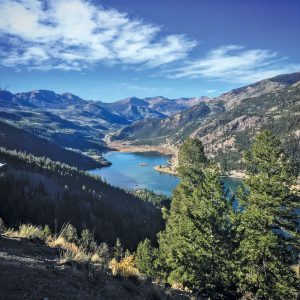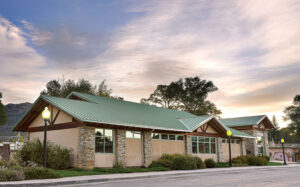By Ed Berg
Solitary hikes with the family dogs are a source of relief from the anger, intolerance and antagonistic noise of this extraordinary election year in the U.S.A. I recently discovered a gulch north of town that is too steep and boulder-choked for a bike trail or even a foot path … not even a deer trail. I was clambering up it at that magical moment when the sun gets just high enough to pour into the gulch and backlight the foliage with brilliant halos. (I avoid using the word “coronas.”) So it was especially dismaying to find an empty plastic one-gallon water jug lodged between two boulders there. I checked the label before crushing it to stow in my backpack. Arrowhead “Spring Water.” A gift from Nestlé. It was labeled “A Local Favorite.” My knee-jerk reaction was that it felt like salt rubbed in a wound mixed with the stink of fresh bullshit. On further thought, it occurred to me that although Nestlé spreads billions of plastic bottles around the world, it took another person to toss away that bottle. Then it struck me that this was not the convenient half-liter throwaway we so frequently pick up along our roadways and trails. No one carries an eight-pound jug of water on an afternoon bike ride.
Walking along the mesa above the gulch, I soon passed by two homeless camps, jumbled piles of discarded sleeping bags, tarps and convenience food containers and plastic wrappers. The dogs alerted, so I knew the camps were occupied. When homeless wanderers abandon their camps, they walk away from the tarps and bags and food containers; discarded refuse left behind by the discarded humans of our extraction economy. Here was the real source of the water jug: not vagrants, not even Nestlé; the source of the toxic waste in our environment is the extraction in our economy and society.
If there is a positive spin on the otherwise absurd “A Local Favorite,” it is that Nestlé recognizes the market power of “local.” The word connotes authentic, healthy, and fresh, and “local favorite” suggests that the local people know a good thing. I agree. We moved here or stayed here because we know a good thing. The Envision Chaffee County survey showed that preserving agricultural land and keeping the rural character of the County were the local qualities we value most highly.
That is why, during a time of extended severe drought, with more drought years coming, with over 90% of the food we eat shipped in from all over the world and gaps showing up on grocery shelves, with farmland in the Central Colorado headwaters region still being subdivided and turned into mini-desert subdivisions, the idea of permitting the removal of 65 million gallons of water every year from the valley’s irrigation system doesn’t seem like a local good thing so much as local slow suicide.
Sadly, the basis for the relationship of water to humans in Colorado is that it is a commodity to be traded for profit, rather than nurtured as the bloodline that ties plants, animals and soil together in a complex web of well-being that we understand only poorly. No human system can trump natural law. Nature has no ideology and makes no judgement between good and evil, never lies and never fixes blame. But nature, with no malice at all, quickly eliminates unworkable organisms and systems, and leaves no discarded waste in the process.
A good example of an unworkable system is Nestlé’s annual extraction of 65 million gallons of water from a local ecosystem, burning thousands of gallons of diesel fuel to truck it 150 miles to a factory so it can be put into billions of plastic bottles that we flawed humans discard to break down into particles that are toxic to plant and animal life. It’s a system that is currently supported by human laws, but nature will trump these slowly, as the plastic toxins slowly poison us and our food supply, and we either replace the extraction with a regenerative use of the water, or we cease to occupy the land.
Nature doesn’t judge; life is opportunistic and uses whatever comes to hand to continue to survive. So why don’t we take the same approach? Nestlé owns the land and the water rights, and it isn’t likely that we can overturn entrenched laws, but those laws give county commissioners the right to set conditions for granting the extraction permit. Why not create an opportunity for Nestlé to convert part of its permitted water extraction and part of its profit to a model for regenerative resource use?
Abandoned western mining towns are mute testimony to the short life expectancy of extraction economies. Why not give Nestlé an opportunity to create a longer future for its extraction by converting part of it to local regenerative agriculture? A model for this already exists in Alamosa: the Rio Grande Farm Park. (www.riograndefarmpark.org)
Chaffee County already has all the elements needed to create a beacon for local agriculture: we are a magnet for outdoor tourism, we have available ag land close to towns, we have investment vehicles like SOIL Sangre de Cristo, and we have collaborative local farming organizations like Guidestone Colorado, the Upper Arkansas Conservation District and Chaffee County Local Food Coalition, to facilitate gathering all the threads and weaving a tapestry for the future.
Maybe a workable contribution by Nestlé to help found and fund a beacon farm park could be part of their permit renewal. Maybe we could transform the “Local Favorite” salt and bullshit into something lovely, lasting and true, something that benefits everyone … including Nestlé—maybe even something that could benefit a wandering vagrant in need of a job.
Ed Berg is recovering from his retirement from the oil industry by becoming an agricultural activist. It pays to give back to the Earth.
Life in the Upper Ark is sponsored by Ladd and Nita Stevens.


